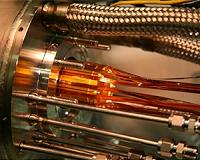 |
Washington DC (SPX) Nov 23, 2010 For more than 250 years, researchers have known that under certain conditions vapor bubbles can form in fluids moving swiftly over a surface. These bubbles soon collapse with such great force that they can poke holes in steel and damage objects such as ship propellers, turbine blades, nozzles and pump impellers. Scientists have conducted extensive research for decades to try to understand this phenomenon - called cavitation. But most experiments to date have been related to open-water objects like ship propellers. Now a group led by Notre Dame professors Patrick Dunn and Flint Thomas has published the first detailed results of experiments aimed at preventing cavitation damage in jet fuel pumps, which are essential components in modern aircraft. Appearing in journal Physics of Fluids, which is published by the American Institute of Physics, the results showed great differences in cavitation behavior between water and JP-8 jet fuel, which is a complex mixture of more than 228 hydrocarbons and additives, each with its own fluid properties. While it can be used to clean jewelry and disintegrate kidney stones, cavitation is usually considered to be highly detrimental and to be avoided. It was first described scientifically by Leonhard Euler in 1754, but the phenomenon made its initial impression with engineers in 1893 when it caused the failure of a propeller on the world's fastest ship at the time, Great Britain's HMS Daring. In modern times, degraded performance is the typical consequence, as maintenance crews usually discover and replace damaged components before they fail. "Improved jet-fuel pumps are needed particularly for military aircraft being designed to fly at higher altitudes and in other demanding environments," Dunn said. "But manufacturers still rely heavily upon trial-and-error in design. If they were confident that a computer-designed pump would work as predicted, new pumps could be lighter, more efficient and have longer lifetimes." The Notre Dame research provides jet-fuel pump designers with the first realistic data that they can use in their computer models to make better predictions of vulnerable locations in their pumps and systems where cavitation bubbles may be created and collapse. It's much more difficult to model cavitation in pumps than in open water, Dunn added, because the fluid typically has a turbulent journey with accelerated flows though small channels, orifices, and spinning discs. With so many constituents, jet fuel is also a computer modeler's nightmare. Its properties can even change with storage conditions and is often contaminated with microparticles that can promote cavitation. The article, "Experimental Characterization of Aviation-Fuel Cavitation" by Patrick F. Dunn, Flint O. Thomas, Michael P. Davis and Irina E. Dorofeeva appears in the journal Physics of Fluids.
Share This Article With Planet Earth
Related Links American Institute of Physics Understanding Time and Space
 Antimatter Atoms Produced And Trapped At CERN
Antimatter Atoms Produced And Trapped At CERNGeneva, Switzerland (SPX) Nov 18, 2010 The ALPHA experiment at CERN has taken an important step forward in developing techniques to understand one of the Universe's open questions: is there a difference between matter and antimatter? In a paper published in Nature today, the collaboration shows that it has successfully produced and trapped atoms of antihydrogen. This development opens the path to new ways of making detailed mea ... read more |
|
| The content herein, unless otherwise known to be public domain, are Copyright 1995-2010 - SpaceDaily. AFP and UPI Wire Stories are copyright Agence France-Presse and United Press International. ESA Portal Reports are copyright European Space Agency. All NASA sourced material is public domain. Additional copyrights may apply in whole or part to other bona fide parties. Advertising does not imply endorsement,agreement or approval of any opinions, statements or information provided by SpaceDaily on any Web page published or hosted by SpaceDaily. Privacy Statement |